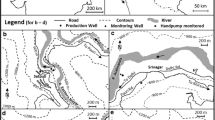Abstract
A hydrochemical and tracer study (uranine injection) was conducted in Jurassic limestone of the Posht-e-Naz area in the Alborz belt to evaluate hydraulic relations between a large diameter (about 100 m) sinkhole and springs and aquifer parameters. A main goal of the project was to find out the source of turbidity of the Emarate drinking water supply spring (SP4) in rainy season. Springs discharge were measured and hydrochemical investigation were carried out. The uranine tracer was injected and eight springs, three wells and the Neka River were selected and totally 989 samples in 107 days were collected. Hydrochemical data demonstrated a relative connection between sinkhole (Sh1) and spring (SP4). The results of the tracing by sampling water indicated only a hydraulic connection between Sange- Nou spring (SP8) and injection point, while the charcoal packets analysis revealed tracer exits from spring numbers SP1, SP3, SP4, SP5, SP8, in wells W1 and W2, and in the Neka River. The concentration — time curves of charcoal packets for qualitative analysis and exit tracer for quantitative analysis is also assessed.
Similar content being viewed by others
References
Bakalowics M (2005) Karst groundwater: a challenge for new resources. Hydrogeology Journal 13: 148–160.
Christy AC, Brian GK, Joshua JH (1999) Hydrochemical evidence for mixing of river water and groundwater during high-flow condition, lower Suwannee river basin, Florida, USA. Hydrogeology Journal 7: 454–467.
Drew D, Hotzel H (1999) Karst hydrogeology and human activities: impacts, consequences and implications, Int Contribution hydrogeology, Rotterdam, Balkema, pp 338.
Ford DC, Williams PW (1989) Karst Geomorphology and Hydrology. Chapman and Hall London. pp 601.
Eckenfelder Inc (1996) Guidelines for well head and spring head protection area delineation in carbonate rocks, US Environmental protection agency, Region 4, Atlanta, Georgia. p127.
Kass W (1999) Dyes: In: W Kass (eds.)), Tracing technique in geohydrology. Rotterdam, Balkema. pp 19–122.
Kogovsek J, Petric M, Liu H (1997) Properties of under ground water flow in karst area near Lunan in Yunnan Province. In:A Kranjc (eds.), Tracer hydrology, Rotterdam, Balkema. pp 255–261.
Lois DG, Ponta G (1999) Dye study tracks historical pathway of VOC-bearing industrial waste water from failed pond at metals coating facility. In: BF Beck, AJ Pettit & G Herring (eds), Hydrogeology and engineering geology of sinkholes and karst, Rotterdam, Balkema. pp 293–299.
Nizar AJ, Alaa K (2008) Groundwater origin and movement in the upper Yarmouk Basin, Northern Jordan. Environmental Geology 54: 1355–1365.
Nur NO, Serdar CB (2008) Temporal variation of chemical and isotopic signals in major discharges of an alpine karst aquifer in Turkey: implications with respect to response of karst aquifers to recharge. Hydrogeology Journal 16:297–309.
Pavicic A, Jvicic D (1997) Drainage basin boundaries of major karst springs in Croatia determined by means of groundwater tracing in their hinterland. In:BF Beck, AJ Pettit and G Herring (eds), Hydrogeology and engineering geology of sinkholes and Karst, Rotterdam. Balkema. pp 273–278.
Smart CC (1988) Quantitative tracing of the maligne karst system, Albert, Canada. Jour of hydrology 98:185–205.
Stevanovic Z, Dragisc V, Papic P, Jemco I (1997) Hydrochemical characteristics of karst groundwater in Serbian Carpatho- Balkanides. In G Gunnay and AI Johnson (eds). Karst waters environmental impacts, Rotterdam Balkema. pp 199–204.
Vesper D, Loop CM, White WB (2003) Contamination transport in karst aquifers. Theoretical and Applied Karstology 13–14:101–111
Vu TMN, Nico G (2006) Tracer tests, hydrochemical and microbiological investigations as a basis for groundwater protection in a remote tropical mountainous karst area, Vietnam. Hydrogeology Journal 14: 1147–1159
Zanini L, Novakowski KS, Lapcevic P, Brckerton GS, Voralek J, Talbot C (2000) Ground water flow in a fractured carbonate aquifer inferred from combined hydrogeological and geochemical measurements. Groundwater 38:350–360
Zarghami M, Raeisi E, Zare M (2007) A dye- tracing test as an aid to studying karst development at an artesian limestone sub-aquifer: Zagros Zone, Iran. Environmental Geology 52: 587–594
Zhou W, Barry FB, Arthur JP, Brad JS (2002) A ground water tracing investigation as an aid of locating groundwater monitoring stations on the Mitchell Plain of southern Indiana. Environmental Geology 41: 842–851
Author information
Authors and Affiliations
Corresponding author
Rights and permissions
About this article
Cite this article
Kalantari, N., Alizadeh, B., Mohammadi, A.R. et al. A hydrochemical and dye- tracing investigation in the Posht-e-Naz Karstic Aquifer, Alburz Mountain, Northern Iran. J. Mt. Sci. 8, 37–45 (2011). https://doi.org/10.1007/s11629-011-1005-2
Received:
Accepted:
Published:
Issue Date:
DOI: https://doi.org/10.1007/s11629-011-1005-2




